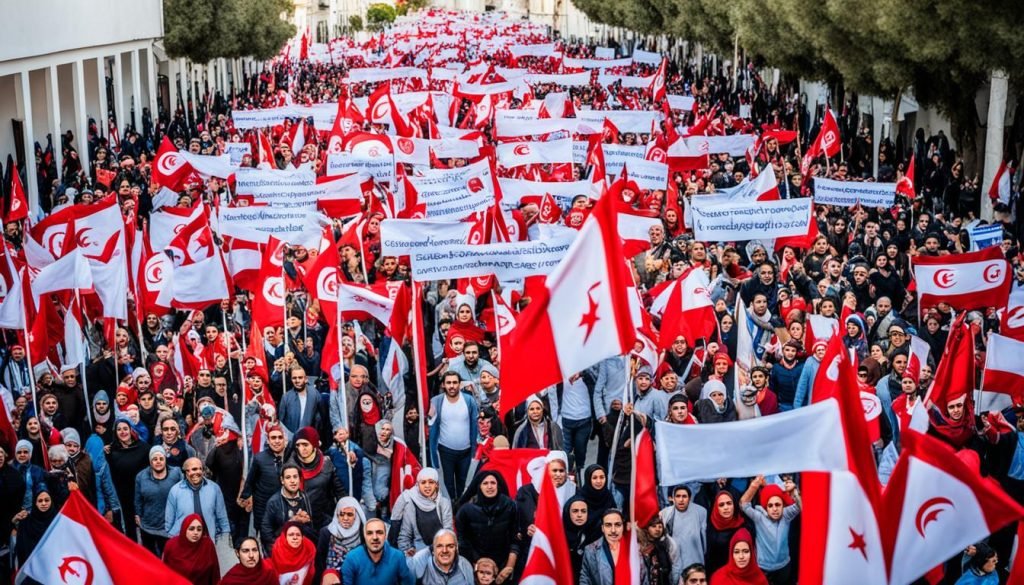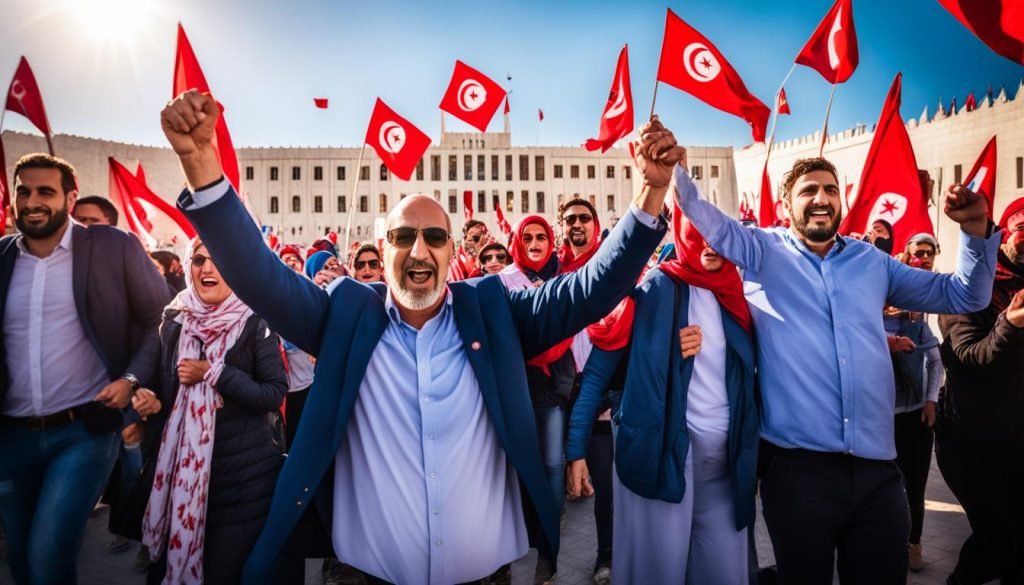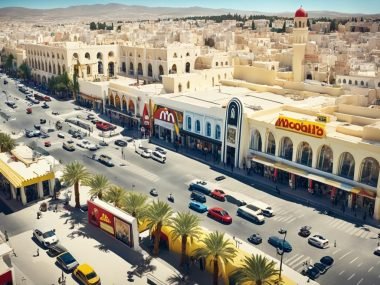I’ve always been fascinated by big changes in history. The Tunisian Revolution sparked the Arab Spring. It started in December 2010. It was driven by too much government control, police harshness, and a young man’s bold stand against unfairness. This was not just a small disturbance. It led to vast changes across a whole area and caused the fall of Tunisia’s leader, Ben Ali.
There was a lot of government corruption, unfairness, and not enough jobs in Tunisia. These issues led to the revolution. When Mohamed Bouazizi set himself on fire, it showed the world how bad things were in Tunisia. This act didn’t just start a revolution in Tunisia. It also started a chain of events where leaders were overthrown and people fought for a better life. The Tunisia uprising was very important. It showed that people could fight against very dark forces and push for democracy.
Let’s go back to those important times. Let’s explore how these events dramatically changed the lives of many. We saw the end of a harsh government, the escape of the Tunisian leader Ben Ali, and the birth of hope. Tunisia then started on a hard but hopeful path towards democracy. This journey was full of hope and danger. It showed the ongoing struggle for a better life across the Arab world.
Key Takeaways
- The Tunisian Revolution was initiated by systemic issues and a single poignant incident.
- Mohamed Bouazizi’s self-immolation acted as a catalyst for widespread change.
- Tunisia’s uprising led to Ben Ali’s downfall and set an example for the Arab Spring.
- The revolution’s aftermath has been a significant move towards democracy within Tunisia.
- The events of the Arab Spring continue to influence the dynamics of the Middle East.
The Inciting Incident: Mohamed Bouazizi’s Self-Immolation
On December 17, 2010, a big change started in Sidi Bouzid. Mohamed Bouazizi, a 26-year-old street vendor, did something brave. He set himself on fire because he was treated very badly by the police and they took his stuff. This act showed how many people were suffering and kicked off a big call for change in the Middle East.
Bouazizi died on January 4, 2011. His death showed the world how much pain people in Tunisia felt. It became a sign of fighting back against unfair treatment. This made people across the Arab countries join in protests and demand better governments.
“Bouazizi’s act was not just one person being upset. It started a big movement for freedom in the Arab world.”
- Officials taking his cart showed how much corruption there was.
- Bouazizi’s extreme action showed how desperate people felt.
- His death made people everywhere support the fight for change.
After what Bouazizi did, many protests started in Tunisia. This was the start of the Arab Spring. It changed how people fought for their rights in the area. Bouazizi’s story is key to understanding How Did Tunisia Start The Arab Spring?
Public Uprising and the Fall of Ben Ali
When Mohamed Bouazizi set himself on fire, it sparked protests across Tunisia. This was the start of major changes. The events in Tunisia didn’t just affect this country. They also influenced the Arab Spring, leading to Ben Ali’s fall.
Initial Government Response to Protests
The Tunisian government first tried to stop the protests with force and small promises. But this didn’t work. The people kept demanding real change, showing a big gap between them and the government.
Days of Rage: Escalation of Civil Resistance
The protests grew into a larger movement of resistance. Strikes and rallies spread across the Middle East. This showed a significant change in politics. The power systems couldn’t stop it, despite pressure from other countries.
Ben Ali’s Abdication and Exile
Facing growing protests and world attention, President Ben Ali stepped down. He fled to Saudi Arabia. His exit on January 14, 2011, wasn’t just about losing a leader. It was a step towards democracy and change in the Middle East.
Bouazizi’s act of protest led to huge changes. It made people rethink power and rule in the Arab world. The revolution showed unhappiness but also hope for others in the region.

| Date | Event | Impact |
|---|---|---|
| December 17, 2010 | Mohamed Bouazizi’s self-immolation | Triggered nationwide protests |
| January 14, 2011 | Ben Ali’s abdication and exile | End of 23-year authoritarian rule |
| Post-January 2011 | Onset of democratization | Inspired Arab Spring in neighboring countries |
Aftermath of the Revolution: Toward Tunisian Democracy
The Tunisia uprising was a big step towards democracy after a tough revolution. Tunisia saw its government fall apart. But it also started building a clearer political system. Big protests in Tunisia changed how politics worked there.
Democratic elections were key to changing how Tunisia was governed. After many years of strict rule, people could now enjoy new political freedoms. They formed many political parties and changed policies. None of this could have happened without the people of Tunisia demanding change.
In October 2011, democratic elections brought together many political groups. The moderate Islamist party Ennahda won, showing a big change. Tunisia moved from dictatorship to a growing democracy that values everyone’s rights. Even though people worried about old problems coming back, the new government worked towards different political views and reforms.
| Event | Date | Impact |
|---|---|---|
| Constitutional Assembly Elections | October 23, 2011 | Formation of a coalition government led by Ennahda; a significant move towards democratic governance. |
| Dissolution of Political Police | 2011 | Enhanced civic freedoms and reduction in state oppression. |
| Release of Political Prisoners | 2011 | Righting past injustices, a crucial step in political reform and national healing. |
Labor unions and civil groups played a big role. They didn’t just participate; they led the push for democracy. Their hard work helped make the country stable. It prepared Tunisia for a democratic future.
The Tunisia uprising matters because it kicked out a dictator. But it’s more important because it keeps moving towards democracy. The fight for a just system, with fair elections, shows the true effect of the Tunisian protests.
The Tunisian Revolution within the Arab Spring Timeline
The Tunisian Revolution caused big waves in the Arab world. It led to much political change and unrest. It showed hope across the Middle East, starting a big shift in politics and society.
Regional Impact of the Tunisian Protests
Tunisia showed the world how people together can make governments listen and bring change. It started a movement across the Arab world. It wasn’t just a win for Tunisia but a spark for a revolution across many nations.
Echoes of Revolution: From Tunisia to Egypt and Beyond
After Tunisia, countries like Egypt and Syria felt inspired to fight against their rulers. These uprisings changed the Middle East a lot. They spread from North Africa to other areas.
In Egypt, the push to remove President Hosni Mubarak grew stronger because of Tunisia. This showed the world’s desire for democracy. Inspired by Tunisia, each country fought for their rights and justice.
The Arab Spring showed how much people want democracy and justice. This desire for change went beyond any one country. It led to a big movement for freedom and reform all over Middle East.
Internal Strife and Political Reforms Post-Revolution
After the Tunisian Revolution, Tunisia’s journey to democracy had its ups and downs. It faced big challenges like political fights. These struggles were chances for growth and change too. The country had to deal with power gaps. This led to some serious events, including the killing of key leaders.
Politics in Tunisia have been a rollercoaster with Islamist and secular groups pulling in different directions. But, progress has been made. One big win was when power was peacefully handed over in 2013. This was thanks to the Tunisian National Dialogue Quartet. They showed that different political sides can work together.
Tunisia showed it could work towards a true democracy, a dream of its people. The democracy movement in Tunisia faced many Tunisia internal political struggles. Yet, it’s a key story of the nation’s effort to maintain democracy and political steadiness.
Tunisia’s Ongoing Struggle for Democracy and Stability
Tunisia is working hard to become a strong democracy. But, the Tunisian Revolution’s impact is still felt today. It has started changes that are both hopeful and hard.
Challenges for Tunisia’s Fledgling Democracy
Tunisia is trying to fix its politics after the revolution. But it’s hard. People aren’t voting much, showing they are unhappy.
From Islamist to Secular Politics: A Volatile Transition
Tunisia is changing from Islamist to secular government. This is a big and risky change. It’s a critical time for the country’s future and leadership.
Economic Woes and the Fight Against Corruption
Fighting corruption is key for Tunisia to do better economically. Even with political changes, problems like joblessness and high costs hurt the country. Corruption slows down new ideas and growth.

| Challenges | Current Status |
|---|---|
| Political Stability | Intermittent, with frequent changes in leadership and policy direction. |
| Economic Growth | Stagnant, plagued by high unemployment rates and tax increases. |
| Anti-Corruption Efforts | Progressing, but still facing significant hurdles due to entrenched practices. |
The journey to democracy in Tunisia is full of ups and downs. The change to secular governance from Islamist rule shows big challenges. Yet, there is hope for a better future and real change.
Conclusion
As I think about the Arab Spring and its start, the Tunisian Revolution always comes to mind. This event changed the political scene in the Arab world. Tunisia showed how to fight against unfair leaders with everyone working together. Seeing Tunisia move from strict rule to democracy is very inspiring.
Tunisia’s story mixes the past and hopes for a democratic future. This uprising became a model for change, not just in Tunisia but in nearby places too. It challenged old ways and aimed for fair, equal, and respectful governance. Though Tunisia’s journey is its own, it shares a common dream for better government and justice.
What the Tunisian Revolution will fully lead to is still unknown. The Arab Spring’s effects are still shaping the area’s social and political life. I try to understand the big changes during this time that keep influencing Arab world discussions. Tunisia stands out in the global push for democracy. It shines as a symbol of strong will and hope in the fight for respect and dignity.







